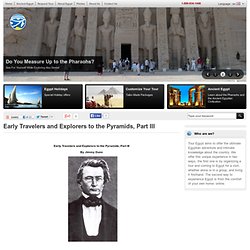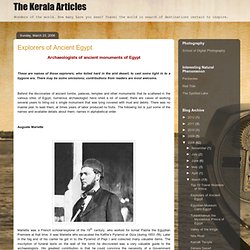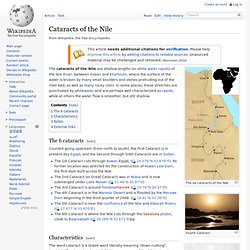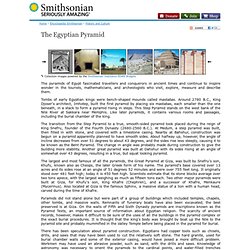

Interactive Dig - Archaeology Magazine's Online Excavations. History of Ancient Egypt. Early Travelers and Explorers to the Pyramids, Part III. Early Travelers and Explorers to the Pyramids, Part III By Jimmy Dunn It was a gradual process, but fortunately for us today, the exploration of Egypt and particularly the pyramids, after the exploits of the earliest antiquarians, took on a more disciplined approach by scholars.

The preservation and recording of ancient Egypt by the mid 1800s began to take precedence over the more brutal excavation methods of the early part of the century. One of the first great scholars, widely held to be the greatest Egyptologist after Champollion, was Karl Richard Lepsius (1810-1884). He first studied classical archaeology in Germany, but went on to study Egyptology in Paris. List of Egyptian gods and goddesses. History - Ancient History in depth: Mummy Maker.
Explorers of Ancient Egypt. Archaeologists of ancient monuments of These are names of those explorers; who toiled hard in the arid desert; to cast some light in to a bygone era.

There may be some omissions; contributions from readers are most welcome. Behind the discoveries of ancient tombs, palaces, temples and other monuments that lie scattered in the various sites of ; numerous archaeologist have shed a lot of sweat; there are cases of working several years to bring out s single monument that was lying covered with mud and debris. An Egyptian Storybook for Kids.
Cataracts of the Nile. The six cataracts of the Nile Fourth Cataract Sixth Cataract The cataracts of the Nile are shallow lengths (or white water rapids) of the Nile River, between Aswan and Khartoum, where the surface of the water is broken by many small boulders and stones protruding out of the river bed, as well as many rocky islets.

In some places, these stretches are punctuated by whitewater and are perhaps well characterized as rapids, while at others the water flow is smoother, but still shallow. The 6 cataracts[edit] Counted going upstream (from north to south), the First Cataract is in present day Egypt; and the Second through Sixth Cataracts are in Sudan. Characteristics[edit] The word cataract is a Greek word literally meaning "down-rushing", "rapids", "floodgate" or "waterfall". Despite these characteristics, some of the cataracts which are normally impassable by boat because of the shallow water have become navigable during the flood season.
Notes[edit] External links[edit] Cataract photos links: Suez Canal. The canal is owned and maintained by the Suez Canal Authority[6] (SCA) of Egypt.

Under international treaty, it may be used "in time of war as in time of peace, by every vessel of commerce or of war, without distinction of flag. "[7] History[edit] Northern outlet of the Suez Nile–Red Sea Canal(s)[edit] Ancient west–east canals were built to facilitate travel from the Nile to the Red Sea.[8][9][10] One smaller canal is believed to have been constructed under the auspices of either Senusret II[11] or Ramesses II.[8][9][10] Another canal, probably incorporating a portion of the first,[8][9] was constructed under the reign of Necho II; however, the only fully functional canal was engineered and completed by Darius I.[8][9][10] 2nd millennium BC[edit] The legendary Sesostris (likely either Pharaoh Senusret II or Senusret III of the Twelfth dynasty of Egypt[11][12]) is suggested to have perhaps started work on an ancient canal joining the River Nile with the Red Sea (1897 BC–1839 BC). 165.
Video on going through the Suez Canal. What Is Egypt's Suez Canal - History and Politics of Egypt's Suez Canal. Answer: The Suez Canal is a 100-mile artificial waterway (160 km) connecting the Gulf of Suez and the Red Sea to the south, at the port city of Suez, with the Mediterranean Sea to the north, at Port Said.

It was opened to shipping in 1869, when it was just 30 feet deep (9 meters) and 100 feet wide (30 meters). The canal significantly reduced travel time between Europe and East Africa, India, the Far East and Japan. The Suez Canal's 19th Century Origins Notions of a canal were first thought out by followers of Socialist French thinker Claude Henri de Rouvray, Comte de Saint Simon (1760-1825). But it was designed by French diplomat Ferdinand de Lesseps, who was close to Egyptian viceroy Muhammad Said Pasha.
Suez Canal opens — History.com This Day in History — 11/17/1869. Encyclopedia Smithsonian: The Egyptian Pyramid. The pyramids of Egypt fascinated travellers and conquerors in ancient times and continue to inspire wonder in the tourists, mathematicians, and archeologists who visit, explore, measure and describe them.

Tombs of early Egyptian kings were bench-shaped mounds called mastabas. Around 2780 B.C., King Djoser's architect, Imhotep, built the first pyramid by placing six mastabas, each smaller than the one beneath, in a stack to form a pyramid rising in steps. Pyramids. Egyptian Pyramids — History.com Articles, Video, Pictures and Facts.
Egypt Map. How to Make a Pyramid. Egyptian Hieroglyphs. Egyptian Life. Cartouche - Ancient Egypt for Kids. Eternal Egypt - Home. The Children's University of Manchester.